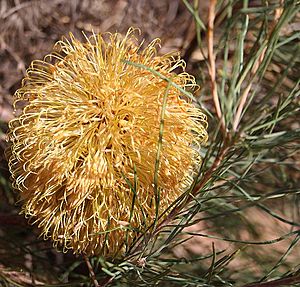Banksia leptophylla facts for kids
Quick facts for kids Banksia leptophylla |
|
|---|---|
 |
|
| var. leptophylla Burma Road |
|
| Scientific classification | |
| Genus: |
Banksia
|
| Species: |
leptophylla
|
| Synonyms | |
|
|
Banksia leptophylla is a type of shrub. It is found only in the southwest part of Western Australia. This plant has thin, long leaves. It produces heads of yellow or pale brown flowers. These flowers have a yellow or purple style. Later, up to eight egg-shaped seed pods, called follicles, grow in each head.
Contents
What it Looks Like
Banksia leptophylla is a very branched shrub. It usually grows up to 2 meters (about 6.5 feet) tall. It can spread up to 3 meters (about 10 feet) wide. This plant does not form a special underground stem called a lignotuber.
Its leaves are narrow and straight. They are about 40 to 100 millimeters (1.5 to 4 inches) long. They are only 1 to 1.5 millimeters (about 0.04 to 0.06 inches) wide. The leaves grow on a short stalk, about 1 to 2 millimeters long.
The flowers grow in a cluster, called a head. Each flower head is about 30 to 100 millimeters (1 to 4 inches) long. They grow on a short side branch. The flowers are pale yellow or light brown. Each flower has a part called a perianth that is 33 to 45 millimeters long. It also has a hooked pistil that is 34 to 58 millimeters long.
Banksia leptophylla flowers throughout the year. It blooms from January to December. After flowering, it forms seed pods. These pods are elliptic, or oval-shaped. There can be eighty or more pods in each head. Each pod is about 15 to 30 millimeters (0.6 to 1.2 inches) long. They are about 5 to 12 millimeters high and 6 to 10 millimeters wide.
How it Got its Name
Banksia leptophylla was first officially described in 1981. This was done by a scientist named Alex George. He published his description in a science journal called Nuytsia.
George's description was based on an earlier name. This name was Banksia pinifolia by Carl Meisner. But this name was not allowed. Another scientist, Richard Anthony Salisbury, had already used it for a different plant. The name leptophylla comes from ancient Greek words. Leptos means "fine" or "slender." Phyllon means "a leaf." This refers to the plant's thin leaves.
In 1988, Alex George described two types, or varieties, of this species. These names are still accepted today:
- Banksia leptophylla var. leptophylla: This type flowers in summer and autumn. Its perianth is 42 to 47 millimeters long.
- Banksia leptophylla var. melletica: This type flowers in winter. It has a shorter perianth than the first type.
Before Alex George's work in 1981, this plant was often called B. sphaerocarpa var. pinifolia or var. major. These were informal names.
Where it Grows
The leptophylla variety grows in shrubland and a type of plant community called kwongan. You can find it between Tathra National Park and Moora.
The melletica variety also grows in kwongan. It is found closer to the coast. Its range is between Kalbarri and Guilderton.
Plant Life and Environment
Banksia leptophylla is one of five Banksia species. These are all related to B. sphaerocarpa. These plants have very unusual flower nectar. Most Banksia species produce clear, watery nectar. But the nectar of these five species is different. It starts pale yellow. Then it slowly gets darker and thicker. Within a day or two, it turns into a thick, olive-green goo. Eventually, it becomes an almost black, sticky lump at the base of the flowers.
A scientist named Byron Lamont first noticed this in 1980. He thought tiny living things called cyanobacteria were causing it. He thought they were feeding on the nectar's sugars. He wondered if they were helping the plant by fixing nitrogen from the air. This nitrogen could then be washed off by rain and used by the plant's roots. However, later studies did not find evidence of nitrogen fixing. More research in 1996 suggested that the color change is not caused by tiny living things. Instead, it is a chemical reaction from the plant itself.
Scientists have also looked at how climate change might affect B. leptophylla. They found that its natural area is unlikely to shrink. It might even grow. This depends on how severe the climate change is. It also depends on how well the plant can move into new areas.
How it is Protected
Both varieties of B. leptophylla are currently considered "not threatened." This classification comes from the Western Australian Government's Department of Parks and Wildlife.
- Taylor, Anne; Hopper, Stephen (1988). The Banksia Atlas (Australian Flora and Fauna Series Number 8). Canberra: Australian Government Publishing Service. ISBN 0-644-07124-9.

